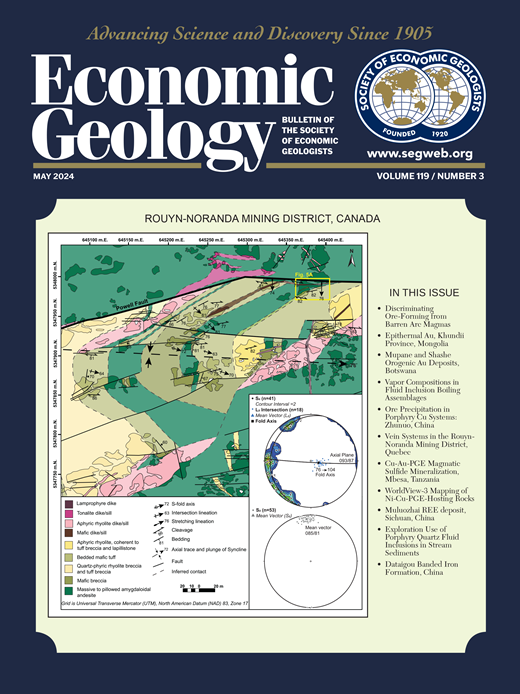爱尔兰银矿磷灰石U-Pb定年:热液矿床成因模式
IF 4.9
1区 地球科学
Q1 GEOCHEMISTRY & GEOPHYSICS
引用次数: 1
摘要
对爱尔兰Silvermines矿床富重晶石Magcobar带热液白云岩角砾岩中不同寻常的粗粒磷灰石晶体进行铀- pb定年,表明其热液蚀变年龄为331±5.6 Ma。该年龄与黄铁矿-闪锌矿的Re-Os年龄一致,但与以往基于银矿古磁学和闪锌矿Rb-Sr年代学的估计不同。新的U-Pb年龄表明该矿床主要是表生形成的,而不是同沉积矿床。磷灰石的微量元素组成为银矿热液系统的地球化学演化提供了额外的约束,表明它是由氧化流体的排出引起的早期赤铁矿-二氧化硅沉淀。随后形成了含重晶石和磷灰石的热液白云岩角砾岩。含金属热液流体的渗透可能来源于基底,与热液白云岩角砾岩发育重叠,在白云化和重晶石沉淀过程中与石炭系海水相互作用。近海底生物活性可能由于热液的逸出而增强,导致海水硫酸盐减少,含硫化物流体的形成,促进了银矿铅锌矿床的发育。本文章由计算机程序翻译,如有差异,请以英文原文为准。
U-Pb DATING OF APATITE FROM SILVERMINES DEPOSIT, IRELAND: A MODEL FOR HYDROTHERMAL ORE GENESIS
Uranium-Pb dating of unusual coarse-grained apatite crystals from hydrothermal dolostone breccia in the barite-rich Magcobar zone at the Silvermines deposit, Ireland, indicates an age of 331 ± 5.6 Ma for hydrothermal alteration. This age is in agreement with an Re-Os age on pyrite-sphalerite but differs from previous estimates that were based on palemomagnetism and sphalerite Rb-Sr geochronology at Silvermines. The new U-Pb age indicates the deposit largely formed epigenetically rather than as a synsedimentary deposit. The trace element composition of the apatite provides additional constraints on the geochemical evolution of the Silvermines hydrothermal system indicating that it was initiated with the expulsion of oxidizing fluids responsible for early hematite-silica precipitation. This was followed by the formation of hydrothermal dolostone breccias containing barite and the apatite dated here. The infiltration of metal-bearing hydrothermal fluids, likely derived from the basement, overlapped and followed the development of hydrothermal dolostone breccias, interacting with Carboniferous seawater during dolomitization and barite precipitation. Near-sea-floor biogenic activity, possibly enhanced due to escape of hydrothermal fluids, resulted in the reduction of seawater sulfate and formation of the sulfide-bearing fluids that facilitated the development of the Silvermines Zn-Pb deposit.
求助全文
通过发布文献求助,成功后即可免费获取论文全文。
去求助
来源期刊

Economic Geology
地学-地球化学与地球物理
CiteScore
10.00
自引率
6.90%
发文量
120
审稿时长
6 months
期刊介绍:
The journal, now published semi-quarterly, was first published in 1905 by the Economic Geology Publishing Company (PUBCO), a not-for-profit company established for the purpose of publishing a periodical devoted to economic geology. On the founding of SEG in 1920, a cooperative arrangement between PUBCO and SEG made the journal the official organ of the Society, and PUBCO agreed to carry the Society''s name on the front cover under the heading "Bulletin of the Society of Economic Geologists". PUBCO and SEG continued to operate as cooperating but separate entities until 2001, when the Board of Directors of PUBCO and the Council of SEG, by unanimous consent, approved a formal agreement of merger. The former activities of the PUBCO Board of Directors are now carried out by a Publications Board, a new self-governing unit within SEG.
 求助内容:
求助内容: 应助结果提醒方式:
应助结果提醒方式:


